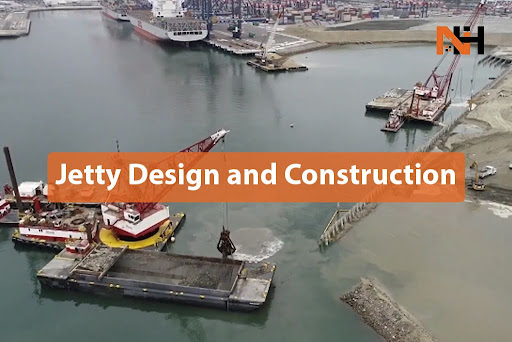
◈ Jetty Design and Construction: Types, Materials Used, Repairs, and More
Jetties are essential structures used in various coastal and marine environments to provide safe navigation for vessels and protect shorelines from erosion. They are carefully designed and constructed to withstand the forces of waves, tides, and currents. This article delves into the intricacies of jetty design, construction, the materials used, and repair methods.
Types of Jetties
Jetties come in different forms, each serving a
specific purpose:
1. Tidal Jetties
Tidal jetties, also known as training jetties, are designed to control and direct the flow of water in tidal inlets and harbors. They prevent silt and sand from accumulating, ensuring safe navigation for ships.
2. Wave-Dissipating Jetties
Wave-dissipating jetties are constructed to absorb and dissipate the energy of incoming waves, thereby reducing the impact on adjacent shorelines and structures.
3. Fishing Jetties
Fishing jetties are built primarily for recreational or commercial fishing. They extend into the water to provide access to deeper fishing grounds.
4. Pier Jetties
Pier jetties are versatile structures used for various purposes, including recreation, fishing, and vessel mooring.
Jetty Design
The design of a jetty is a complex process that
takes into account factors like local wave conditions, sediment transport,
navigational requirements, and environmental considerations. A well-designed
jetty can significantly influence its effectiveness and longevity.
A. Hydrodynamic Considerations
1. Wave Conditions: The jetty's length and shape must be
designed to withstand the wave height and period in the area.
2. Tidal Range: Tidal variations determine the jetty's elevation and water depth around it.
3. Sediment Transport: Understanding sediment movement is vital to prevent accumulation on one side of the jetty and erosion on the other.
B. Structural Components
1. Foundation: A solid foundation is crucial to support
the jetty structure. Pile or sheet pile foundations are commonly used.
2. Superstructure: The jetty's deck is where various facilities can be added, such as navigation aids, mooring points, or fishing platforms.
3. Armor Units: To protect against erosion, jetty structures may be lined with concrete, rock, or other armor units.
Materials Used in Jetty Construction
The materials used in jetty construction are
selected based on factors like durability, resistance to saltwater corrosion,
and the specific purpose of the jetty. Common materials include:
1. Concrete
Reinforced concrete is often used for the superstructure and armor units due to its strength and durability. It can withstand the harsh marine environment and is resistant to corrosion.
2. Rock or Riprap
Large rocks or riprap are employed for shoreline protection and wave dissipation. They absorb wave energy, preventing erosion.
3. Timber
In some cases, pressure-treated timber is used for the construction of pier jetties. It provides a natural aesthetic and is suitable for recreational purposes.
Jetty Construction
The construction of a jetty is a meticulous process that requires careful planning, engineering expertise, and adherence to safety standards. Here are the key steps involved:
A. Site Preparation
1. Survey the site to understand
environmental conditions and sediment transport patterns.
2. Clear the area of any obstacles, such as vegetation and debris.
B. Foundation Construction
1. Install foundation elements,
like piles or sheet piles, to support the jetty's weight and resist the
forces of waves and currents.
C. Superstructure Construction
1. Build the superstructure using reinforced concrete or other suitable materials.
2. Add navigational aids, lighting, or other necessary facilities.
D. Armor Units Installation
1. Line the jetty with armor
units, such as concrete blocks or riprap, to protect against erosion and
wave action.
E. Finishing Touches
1. Conduct inspections to ensure structural integrity.
2. Landscape the area around the jetty to improve aesthetics and accessibility.
Jetty Repairs and Maintenance
Jetties, like any other structures in a marine
environment, require regular maintenance and occasional repairs to ensure their
functionality and longevity. Common maintenance activities include:
1. Cleaning and Debris Removal:
Regularly removing debris and sediments from the jetty area.
2. Erosion Control: Replenishing armor units or rock revetments to combat erosion.
3. Structural Inspections: Periodic assessments of the jetty's structural integrity to identify and address issues.
4. Corrosion Protection: Applying protective coatings to steel or concrete elements to prevent corrosion.
Conclusion
Jetties play a crucial role in coastal management and maritime navigation. The design and construction of these structures are complex processes that require a deep understanding of hydrodynamics and materials engineering. Moreover, regular maintenance and repairs are essential to ensure their continued effectiveness in protecting shorelines and facilitating safe navigation. Properly designed and well-maintained jetties are not only functional but also contribute to the beauty and sustainability of coastal areas.
For further information on this topic, you can
explore resources provided by The American Society of Civil Engineers.
